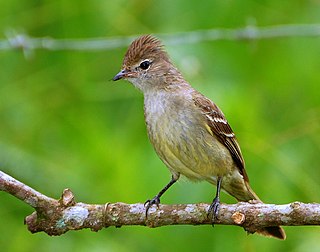
The yellow-bellied elaenia is a small bird in subfamily Elaeniinae of family Tyrannidae, the tyrant flycatchers. It is found in Mexico, in every Central American country, in every mainland South American country except Chile, on Trinidad and Tobago, and on several islands in the Lesser Antilles.

The southern beardless tyrannulet is a small passerine bird in subfamily Elaeniinae of family Tyrannidae, the tyrant flycatchers. It is found in Costa Rica, Panama, in every mainland South American country except Chile, and on Trinidad.
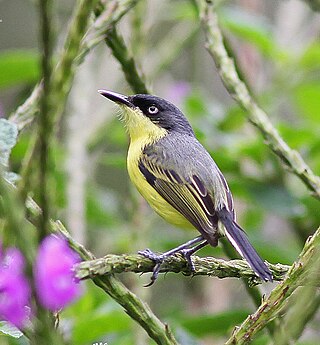
The common tody-flycatcher or black-fronted tody-flycatcher is a very small passerine bird in the tyrant flycatcher family. It breeds from southern Mexico to northwestern Peru, eastern Bolivia and southern, eastern and northeast Brazil.

The lesser elaenia is a species of bird in subfamily Elaeniinae of family Tyrannidae, the tyrant flycatchers. It is found in Costa Rica, Panama, on Trinidad, in every mainland South American country except Chile and Uruguay, and as a vagrant on Bonaire and Curaçao.

The white-throated tyrannulet is a species of bird in subfamily Elaeniinae of family Tyrannidae, the tyrant flycatchers. It is found in Argentina, Bolivia, Brazil, Colombia, Ecuador, Peru, and Venezuela.

The sulphur-bellied tyrannulet is a species of bird in subfamily Elaeniinae of family Tyrannidae, the tyrant flycatchers. It is found in Colombia, Ecuador, Peru, and Venezuela.

The white-tailed tyrannulet is a species of bird in subfamily Elaeniinae of family Tyrannidae, the tyrant flycatchers. It is found in Colombia, Ecuador, and Peru.

The white-banded tyrannulet is a species of bird in subfamily Elaeniinae of family Tyrannidae, the tyrant flycatchers. It is found in Bolivia, Colombia, Ecuador, Peru, and Venezuela.

The black-tailed myiobius or black-tailed flycatcher is a species of passerine bird in the family Tityridae. It was previously placed in the family Tyrannidae. Black-tailed flycatchers are found in Brazil, Colombia, Costa Rica, Ecuador, Panama, Peru, and Venezuela. Their natural habitats are subtropical or tropical moist lowland forests and heavily degraded former forest. They are usually found alone or in pairs, but may join flocks of several species.
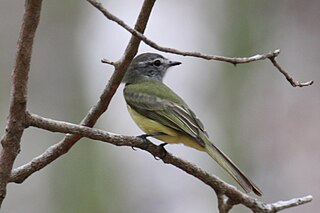
The greenish elaenia is a species of bird in subfamily Elaeniinae of family Tyrannidae, the tyrant flycatchers. It is found in Mexico, every Central American country, and every mainland South American country except Chile and French Guiana. It has also occurred as a vagrant in southern Texas.

The white-browed antbird is a species of perching bird in subfamily Thamnophilinae of family Thamnophilidae, the "typical antbirds". It is found in every mainland South American country except Argentina, Chile, Paraguay, and Uruguay.
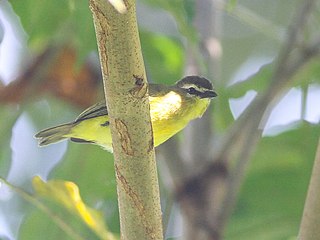
The brown-capped tyrannulet is a species of bird in subfamily Elaeniinae of family Tyrannidae, the tyrant flycatchers. It is found in Colombia, Costa Rica, Ecuador, Panama, and Venezuela and reported for the first time in Nicaragua in 2011.

The white-lored tyrannulet is a species of bird in subfamily Elaeniinae of family Tyrannidae, the tyrant flycatchers. It is found in Bolivia, Brazil, Colombia, Ecuador, French Guiana, Guyana, Peru, Suriname, and Venezuela.

The yellow-bellied tyrannulet is a species of bird in subfamily Elaeniinae of family Tyrannidae, the tyrant flycatchers. It is found in Belize, Costa Rica, Guatemala, Honduras, Mexico, Nicaragua, and Panama.
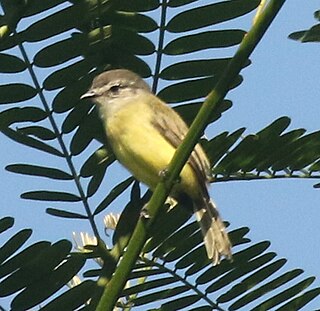
The sooty-headed tyrannulet is a species of bird in subfamily Elaeniinae of family Tyrannidae, the tyrant flycatchers. It is found in Brazil, Colombia, Ecuador, French Guiana, Guyana, Panama, Peru, Suriname, and Venezuela.

The plumbeous-crowned tyrannulet is a species of bird in subfamily Elaeniinae of family Tyrannidae, the tyrant flycatchers. It is found in Colombia, Ecuador, and Peru.
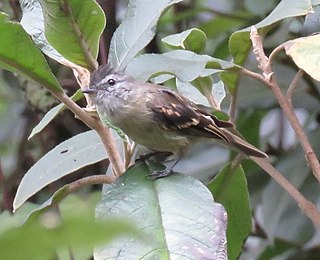
The tawny-rumped tyrannulet is a species of bird in subfamily Elaeniinae of family Tyrannidae, the tyrant flycatchers. It is found in Bolivia, Colombia, Ecuador, Peru, Venezuela, and possibly Argentina.

The yellow-crowned tyrannulet is a species of bird in subfamily Elaeniinae of family Tyrannidae, the tyrant flycatchers. It is found in Costa Rica, Panama, and in every mainland South American country except Argentina, Chile, Paraguay, and Uruguay.

The white-fronted tyrannulet is a species of bird in subfamily Elaeniinae of family Tyrannidae, the tyrant flycatchers. It is found in Bolivia, Colombia, Costa Rica, Ecuador, Panama, Peru, and Venezuela.

The northern mouse-colored tyrannulet is a species of bird in subfamily Elaeniinae of family Tyrannidae, the tyrant flycatchers. It is found in Colombia, Costa Rica, Ecuador, Guyana, Panama, Trinidad, Venezuela, and possibly Brazil, French Guiana, and Suriname.
























